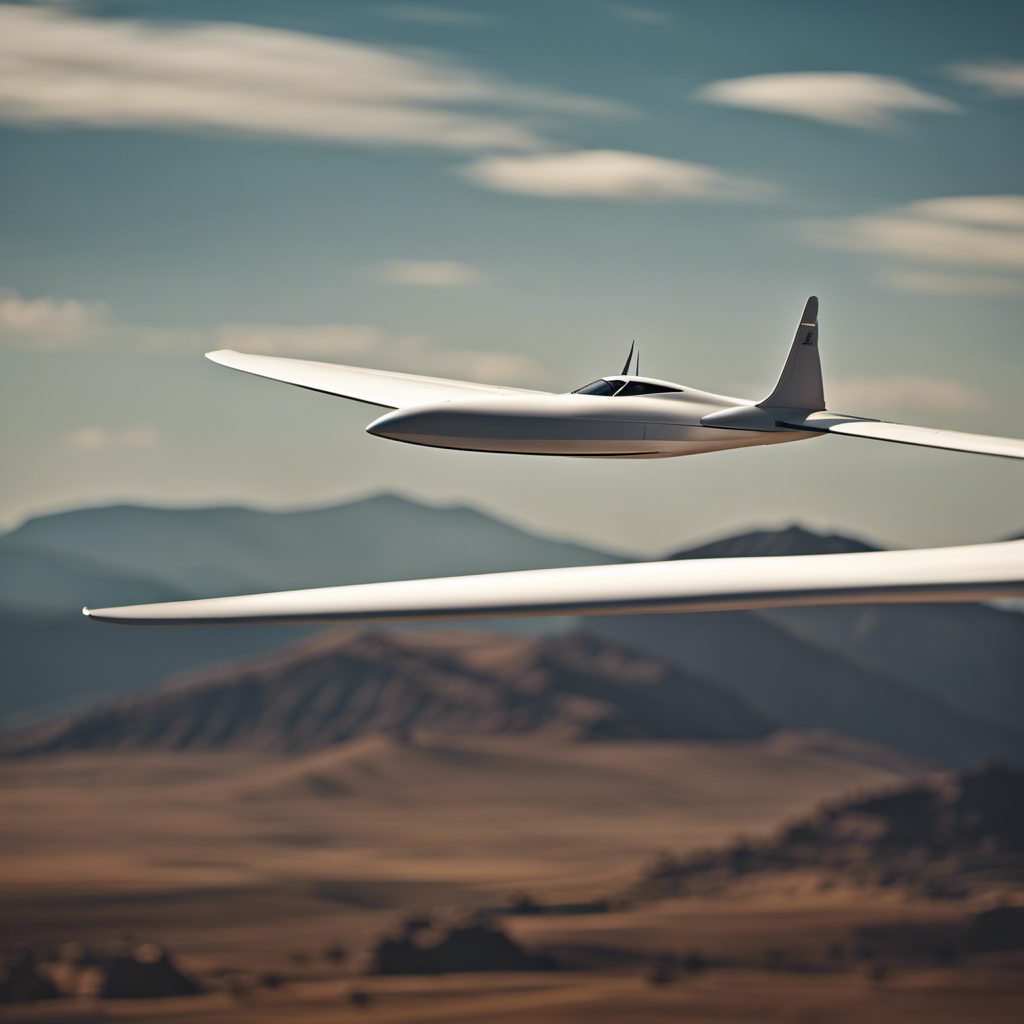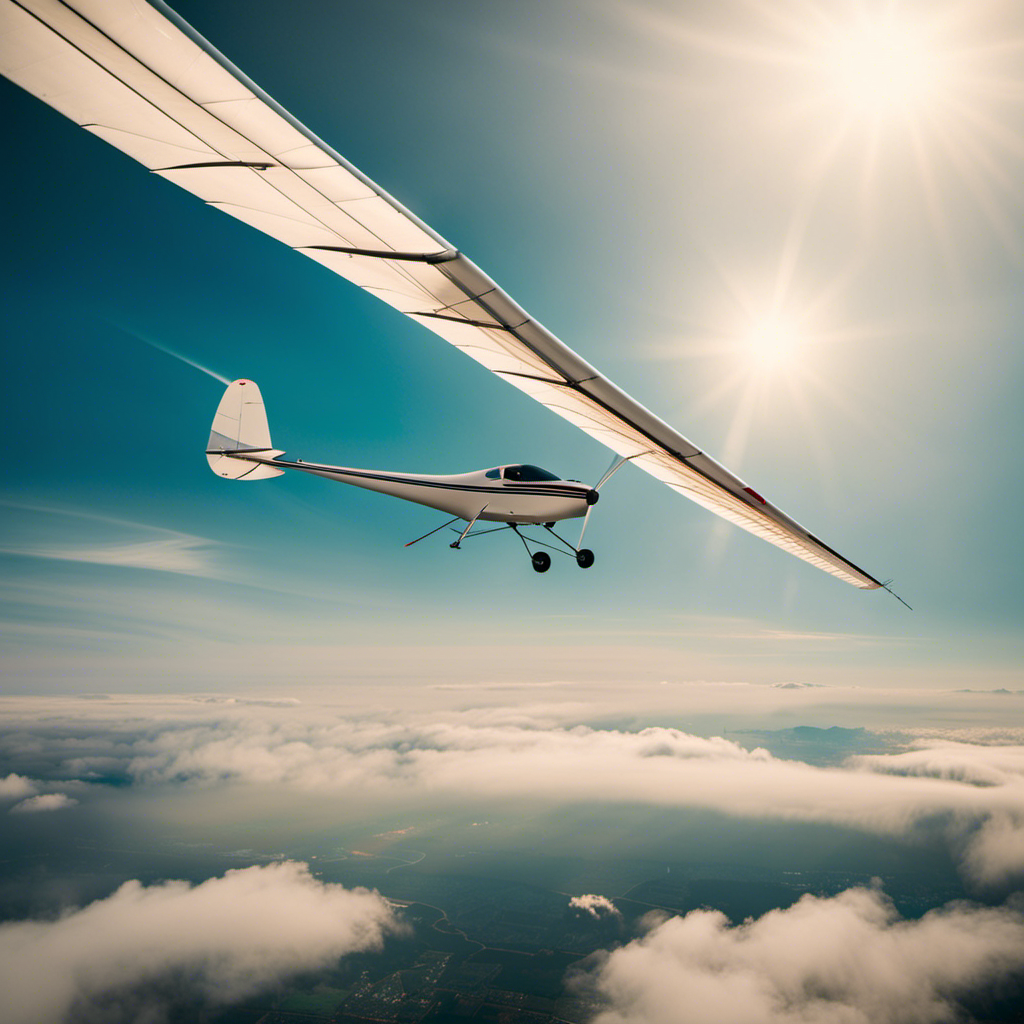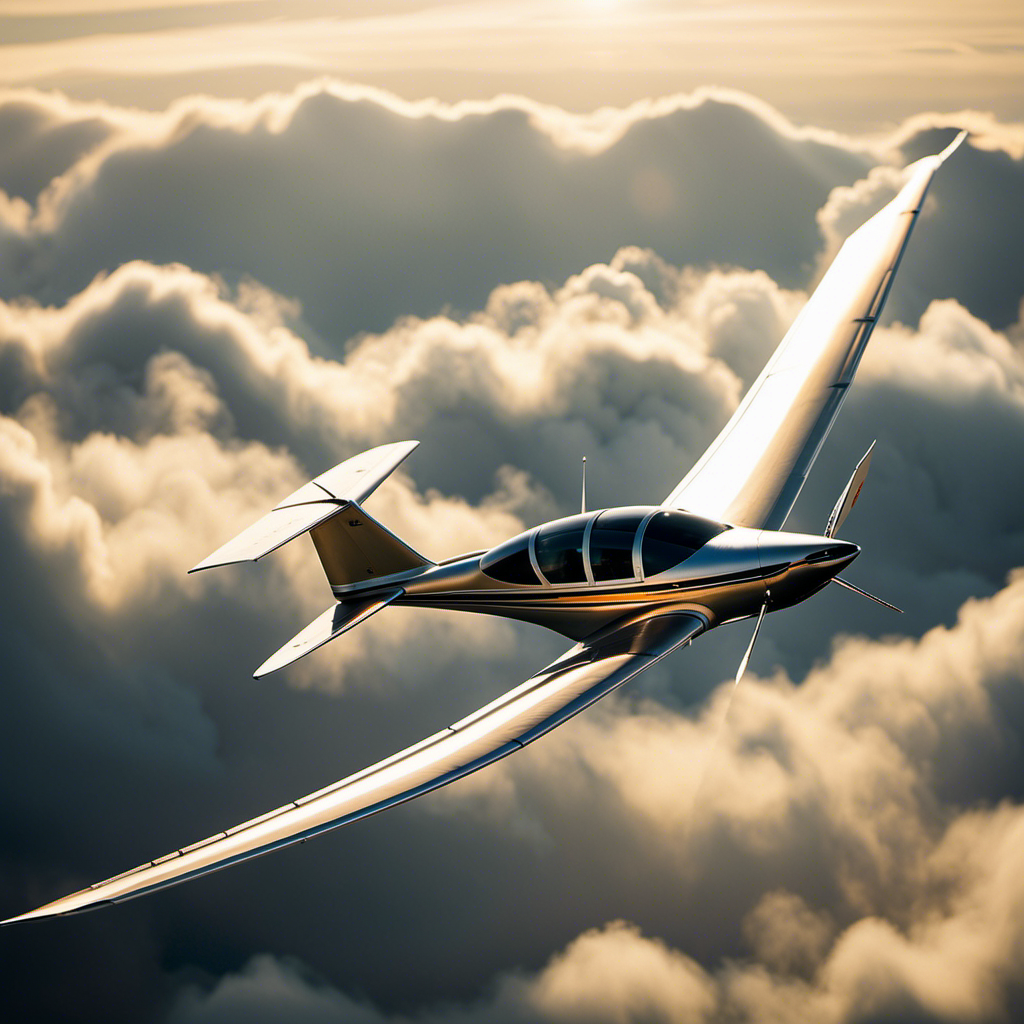Are you interested in soaring efficiently through the skies? If you’re curious about the optimal wing setup for gliders, you’ve come to the right place.
In this article, we delve into the intricacies of wing efficiency in glider design, exploring the factors that contribute to lift and drag.
We’ll analyze different wing designs, examine the role of airfoils, and consider aerodynamic considerations.
Strap in as we take you on a journey through the world of glider wing design, where every detail counts.
Key Takeaways
- Wing efficiency is crucial for glider performance as it determines range, endurance, speed, and maneuverability.
- The shape and angle of attack of the wing affect lift, while wing shape, air density, and speed influence drag.
- Different wing designs, such as rectangular, tapered, and elliptical, offer various advantages in terms of simplicity, drag reduction, and performance at low speeds.
- The airfoil shape, including camber and thickness, plays a significant role in determining lift and drag characteristics, while higher aspect ratio wings have lower drag. Control surfaces further enhance efficiency and maneuverability.
The Importance of Wing Efficiency in Glider Design
The efficiency of the wing is crucial in determining the performance of a glider. When it comes to glider design, the wing plays a critical role in generating lift and minimizing drag.
The efficiency of a wing is determined by its ability to generate maximum lift with minimum drag. This is achieved through careful design and optimization of various factors such as wing shape, aspect ratio, and airfoil profile.
A well-designed and efficient wing allows a glider to stay aloft for longer periods of time, maximizing its range and endurance. It also enables the glider to achieve higher speeds and better maneuverability.
Understanding lift and drag in glider wings is essential in further optimizing wing efficiency and improving overall glider performance. By analyzing the aerodynamic forces acting on the wing and making appropriate design choices, glider designers can push the boundaries of efficiency and achieve better flight performance.
Understanding Lift and Drag in Glider Wings
Understanding lift and drag in glider wings helps you optimize your flight performance.
Lift is the force that opposes gravity and keeps your glider in the air. It is generated by the shape of the wing and the flow of air over it. The wing’s angle of attack, or the angle at which it meets the oncoming air, greatly affects lift. Increasing the angle of attack can increase lift, but too much can lead to a stall.
Drag, on the other hand, is the force that opposes the motion of your glider through the air. It is caused by air resistance and is influenced by factors such as the shape of the wing, air density, and speed.
By understanding lift and drag, you can make adjustments to your wing design to achieve better performance in terms of lift-to-drag ratio, which is crucial for maximizing glide efficiency and achieving longer flight times.
Now, let’s explore different wing designs to further enhance your glider’s performance.
Exploring Different Wing Designs
To enhance your glider’s performance, let’s delve into exploring various wing designs.
The shape and configuration of a glider’s wings play a crucial role in its overall efficiency and flight characteristics. One of the most common wing designs used in gliders is the rectangular wing. This design offers simplicity and ease of construction, but it may not provide optimal performance.
Another popular wing design is the tapered wing, which has a reduced wing area towards the wingtips. This design helps to reduce drag and improve the glider’s aerodynamic efficiency.
Additionally, the elliptical wing design is known for its low drag and excellent performance at low speeds. Each wing design has its advantages and disadvantages, so it is important to consider your specific needs and flying conditions when choosing the right wing design for your glider.
Transitioning into the role of airfoils in glider wing efficiency, let’s explore how the shape and curvature of airfoils impact the overall performance of a glider’s wing.
The Role of Airfoils in Glider Wing Efficiency
Now let’s dive into how airfoil shape and curvature affect the efficiency of your glider’s wings.
The airfoil, or the cross-sectional shape of the wing, plays a crucial role in determining the lift and drag characteristics of the glider. When it comes to efficiency, there are several key factors to consider:
-
Camber: Camber refers to the curvature of the airfoil. A cambered wing, with a curved upper surface and a flatter lower surface, generates more lift at lower speeds, making it ideal for takeoff and landing.
-
Thickness: The thickness of the airfoil affects the overall lift and drag of the wing. Thicker airfoils generally generate more lift, but they also create more drag. Finding the right balance is essential for maximizing efficiency.
-
Aspect Ratio: The aspect ratio is the ratio of the wing’s span to its average chord length. Higher aspect ratio wings, which are longer and narrower, tend to have lower drag and better efficiency.
-
Control Surfaces: The addition of control surfaces, such as flaps and ailerons, can further enhance the efficiency of the glider’s wings by allowing for better control and maneuverability.
Understanding these factors and their impact on wing efficiency is crucial in designing an optimal glider wing.
With this knowledge, we can now explore the aerodynamic considerations in glider wing design, taking into account various factors that contribute to the overall performance of the aircraft.
Aerodynamic Considerations in Glider Wing Design
When considering aerodynamic factors, it’s important to maximize lift and minimize drag in your glider wing. To achieve this, the shape of the wing plays a crucial role. The most efficient glider wing design typically incorporates a high aspect ratio, which refers to the ratio of the wing’s span to its average chord. A high aspect ratio allows for longer wings, which in turn increases lift while reducing drag.
Additionally, a tapered wing shape helps to minimize the formation of vortices at the wingtips, which can cause unnecessary drag. By carefully considering these aerodynamic factors, you can optimize the performance of your glider wing and achieve greater efficiency in flight.
Transitioning into the subsequent section, let’s now explore the materials and construction techniques that contribute to efficient glider wings.
Materials and Construction Techniques for Efficient Glider Wings
You can achieve optimal performance in flight by carefully selecting the materials and employing effective construction techniques for your glider wings.
The choice of materials is crucial in determining the overall weight, strength, and stiffness of the wings. Lightweight and strong materials, such as carbon fiber composites, are often preferred due to their excellent strength-to-weight ratio.
Additionally, the construction techniques used, such as advanced molding processes and precision assembly methods, play a significant role in reducing drag and improving aerodynamic performance.
By carefully crafting the wings with the right materials and construction techniques, you can maximize lift, minimize drag, and enhance the overall efficiency of your glider.
This seamless transition between materials and construction techniques sets the stage for understanding the role of wing loading in glider performance.
The Role of Wing Loading in Glider Performance
The role of wing loading in glider performance is crucial for achieving optimal flight capabilities. Wing loading refers to the amount of weight that is supported by the surface area of the wings. It directly affects the glider’s ability to generate lift and maintain stability during flight.
Here are three key aspects to consider regarding wing loading:
-
Lift generation: Higher wing loading increases the amount of lift generated by the wings, allowing the glider to stay aloft even at higher speeds.
-
Maneuverability: Lower wing loading enhances the glider’s maneuverability, enabling it to perform tight turns and quick changes in direction.
-
Glider loading: The total weight of the glider, including the payload and pilot, should be carefully considered to ensure the wing loading remains within safe limits.
Understanding and optimizing wing loading is essential for designing efficient glider wings that can maximize performance and achieve the desired flight characteristics.
Transitioning to the next section, testing and optimization of glider wing designs is a critical step in achieving these goals.
Testing and Optimization of Glider Wing Designs
When it comes to testing and optimizing glider wing designs, there are several key points to consider.
First, wind tunnel testing provides a controlled environment to evaluate the performance of different wing configurations. This allows for precise measurements of lift, drag, and other aerodynamic parameters.
Second, computational fluid dynamics (CFD) simulation offers a virtual platform to analyze the airflow around the wings and predict their performance. This method allows for rapid iteration and optimization of wing designs before physical testing.
Lastly, real-world flight testing and data analysis provide valuable insights into the actual performance of the wings in various conditions.
Wind Tunnel Testing for Performance Evaluation
To evaluate the performance of your glider wing design, consider conducting wind tunnel testing. This method allows you to analyze and optimize the aerodynamic characteristics of your design. Here are four reasons why wind tunnel testing is crucial for your glider wing evaluation:
-
Accurate Results: Wind tunnel testing provides precise data on lift, drag, and other aerodynamic forces, giving you a clear understanding of your wing’s performance.
-
Realistic Conditions: By simulating airflow in a controlled environment, wind tunnel testing allows you to replicate real-world conditions and analyze the behavior of your design accurately.
-
Optimization Opportunities: With the data obtained from wind tunnel testing, you can identify areas of improvement and make necessary design modifications to enhance the efficiency and performance of your glider wing.
-
Cost-Effective: Wind tunnel testing provides a cost-effective approach to evaluating your glider wing design before moving on to more expensive and time-consuming testing methods.
Transitioning into the subsequent section about computational fluid dynamics (CFD) simulation, this advanced technique complements wind tunnel testing by providing a virtual environment to further analyze and optimize your glider wing design.
Computational Fluid Dynamics (CFD) Simulation
Transitioning into the subsequent section, you can utilize CFD simulation as a complementary tool to further analyze and optimize your glider wing.
CFD simulation, or Computational Fluid Dynamics simulation, allows you to numerically solve the governing equations of fluid flow around your glider wing. By inputting the geometry, boundary conditions, and flow properties, CFD software can provide detailed information about the aerodynamics of your wing. This includes lift and drag coefficients, pressure distribution, and flow patterns.
CFD simulation enables you to explore a wide range of design parameters, such as wing shape, airfoil profile, and winglet configuration, without the need for physical wind tunnel testing. It provides valuable insights into the flow behavior and performance of different wing designs, helping you make informed decisions during the design process.
Transitioning to the subsequent section, real-world flight testing and data analysis offer a crucial validation of the CFD results, allowing you to further refine your glider wing design based on actual flight performance.
Real-world Flight Testing and Data Analysis
Now that you have gained a thorough understanding of Computational Fluid Dynamics (CFD) simulations, it is time to transition to the next step: real-world flight testing and data analysis.
This stage is crucial in determining the effectiveness and efficiency of different glider wing designs. By subjecting the glider to actual flight conditions, you can gather invaluable data that will inform the design process.
Here are five key aspects to consider during real-world flight testing:
- Airspeed and altitude variations
- Stability and control characteristics
- Drag and lift coefficients
- Wing loading and aspect ratio
- Flight endurance and range
Analyzing these factors will provide you with valuable insights into the performance of different glider wing designs. With this data in hand, you will be able to assess and compare the success of various designs, leading us to the next section: case studies of successful glider wing designs.
Case Studies of Successful Glider Wing Designs
Take a look at some case studies to see how successful glider wing designs have been implemented.
One such case study is the ASH 31, a high-performance glider with an innovative wing design. The ASH 31 features a high aspect ratio wing, which means it has a long and narrow shape. This design reduces drag and increases lift, allowing the glider to maintain altitude and glide for longer distances.
Another case study is the Ventus-2cx, which incorporates a laminar flow wing design. This type of wing is characterized by smooth airflow over its surface, minimizing drag and enhancing performance. The Ventus-2cx has been praised for its efficiency and ability to soar in varying weather conditions.
These case studies highlight the importance of optimizing wing design for glider performance and efficiency.
Transitioning into the future of glider wing design, researchers are continuously exploring new technologies and materials to further enhance performance.
The Future of Glider Wing Design
As you delve into the future of glider wing design, you’ll explore the exciting advancements in aerodynamics and materials. These developments are crucial in achieving maximum efficiency and performance.
Additionally, you’ll analyze the integration of sustainable technologies, as the aviation industry continues to prioritize environmental responsibility.
Advancements in Aerodynamics and Materials
You can explore the advancements in aerodynamics and materials to find the best/most efficient glider wing design.
Through the study of aerodynamics, researchers have been able to refine the shape and structure of glider wings to minimize drag and maximize lift. By utilizing computer simulations and wind tunnel testing, engineers can fine-tune the design to achieve optimal performance.
Additionally, advancements in materials, such as carbon fiber composites, have allowed for lighter and stronger wing structures. These materials offer high strength-to-weight ratios, allowing gliders to achieve greater efficiency and maneuverability.
Furthermore, innovative wing configurations, such as the use of winglets or swept-back wings, can improve aerodynamic performance by reducing vortex drag and enhancing stability.
Integrating sustainable technologies into glider wing design is the next logical progression, allowing for more efficient and environmentally friendly flight without sacrificing performance.
Integration of Sustainable Technologies
By integrating sustainable technologies, engineers can enhance the efficiency and environmental friendliness of flight in gliders. Here are four ways in which these technologies can be incorporated:
-
Electric Propulsion: By replacing traditional combustion engines with electric motors, gliders can reduce emissions and noise pollution, while also benefiting from improved power-to-weight ratios.
-
Solar Panels: Installing solar panels on the wings of gliders can harness the power of the sun to generate electricity and extend flight times, reducing the reliance on external power sources.
-
Lightweight Materials: Utilizing lightweight and sustainable materials, such as carbon fiber composites, can reduce the weight of gliders, increasing their efficiency and reducing fuel consumption.
-
Regenerative Braking: By incorporating regenerative braking systems, gliders can capture and store energy that is generated during descent, which can be used to power onboard systems during subsequent flights.
With these sustainable technologies, gliders can achieve greater efficiency and reduce their impact on the environment.
Now, let’s delve into the pursuit of maximum efficiency in glider wings.
The Pursuit of Maximum Efficiency in Glider Wings
To achieve optimal efficiency, it’s crucial to explore various innovative approaches when developing glider wings.
When it comes to maximizing efficiency in glider wings, there are several key factors to consider.
First and foremost is the aspect ratio, which is the ratio of the wingspan to the average chord length. Higher aspect ratios generally result in lower induced drag, leading to improved efficiency.
Additionally, the shape and profile of the wing play a significant role. Airfoil design, wing sweep, and winglets all contribute to reducing drag and increasing lift-to-drag ratio.
Furthermore, the use of advanced materials, such as carbon fiber composites, can help reduce weight while maintaining structural integrity.
Lastly, incorporating adaptive wing technologies, such as morphing wings or active control surfaces, can further enhance efficiency by optimizing aerodynamic performance at different flight conditions.
Frequently Asked Questions
How does the weight of the glider impact wing efficiency?
The weight of the glider directly affects wing efficiency. A heavier glider requires more lift to stay airborne, which increases drag and reduces overall efficiency. Lighter gliders have better maneuverability and can generate more lift with less drag.
What are the factors that affect the stall speed of a glider?
The stall speed of a glider is affected by several factors, including wing shape, angle of attack, and air density. These variables interact to determine the minimum speed at which the glider can maintain lift, a critical consideration for safe flight.
Can wingtip devices improve the efficiency of glider wings?
Yes, wingtip devices such as winglets can improve the efficiency of glider wings. By reducing drag and increasing lift, they enhance aerodynamic performance, resulting in improved fuel efficiency and extended gliding range.
How does the aspect ratio of a glider wing affect its performance?
The aspect ratio of a glider wing significantly affects its performance. Higher aspect ratios result in lower induced drag and improved efficiency, while lower aspect ratios provide better maneuverability and stability.
What are the advantages and disadvantages of using a high-lift airfoil in glider wing design?
Using a high-lift airfoil in glider wing design has advantages such as increased lift and reduced stall speed. However, it also has disadvantages like increased drag and reduced maneuverability.
Conclusion
In conclusion, when it comes to glider wing design, there is no one-size-fits-all solution. The most efficient design depends on various factors such as the glider’s purpose, speed, and desired performance.
However, through thorough testing and optimization, designers can achieve remarkable results. Whether it’s the use of innovative airfoils, careful consideration of aerodynamics, or effective wing loading, the future of glider wing design holds great promise.
So, continue to explore, analyze, and push the boundaries of efficiency in glider wing design to soar to new heights.
Orion, better known as “Jetstream,” is the voice that brings the stories of the skies to life. His fascination with aviation began at a young age, sparked by his father’s tales of flying and adventure. Orion’s journey into the world of gliding was serendipitous, and from the moment he took his first glider flight, he knew he had found his calling.










